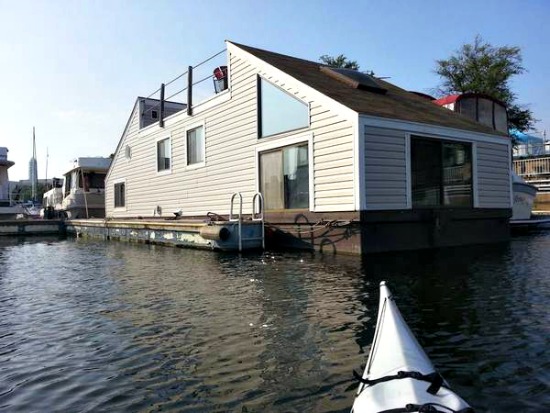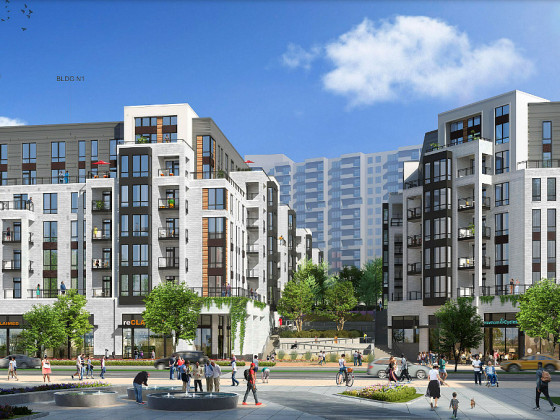 Southwest Waterfront: A Tiny Neighborhood on the Cusp
Southwest Waterfront: A Tiny Neighborhood on the Cusp
✉️ Want to forward this article? Click here.

Rendering of The Wharf
Over the past five years, UrbanTurf has profiled more than 80 neighborhoods in the DC area. See them all here. We are revisiting each of those neighborhoods to update our profiles and see how they've changed over the years. Nestled between the Washington Channel and the Anacostia River, one of the smallest neighborhoods in DC’s smallest quadrant unassumingly chugs along. From the beginning, Southwest Waterfront has been a diverse area – a more spacious, peaceful escape from the rest of the District. However, “The Little Quadrant That Could” is about to get a much bigger personality. Plans already set in motion for major development along the channel will drastically alter the landscape, leaving its façade, as it is now, unrecognizable.
Right Along the Water
Southwest Waterfront inhabits a unique area. While within walking distance of many desirable places in the city – Nats Stadium, the National Mall, Chinatown – it very distinctly remains its own little island. To the north, the Southwest Freeway isolates the neighborhood from the rest of DC. South Capitol Street, on its eastern border, segregates Southwest Waterfront from Navy Yard and Nationals Park. To the south lies Fort McNair and Buzzard Point, while the Washington Channel acts as a natural border to the west.
Urban Renewal Gone Wrong
Though a little sleepy now, in the mid-1800s, the area was a cultural and economic hub. Fishmongers traded and sold fresh fish from boats unloading in the harbor. European immigrants filtered in from Scotland, Ireland, Germany, and other eastern European countries, while many freed slaves landed in the area after the Civil War. At that time, the neighborhood was divided by 4th Street (then, 4 ½ Street) with European immigrants inhabiting the west side, and freed slaves occupying the east side. Over the years, Southwest Waterfront became a home for low-income residents, and the area fell into decline. By 1946 the nation’s first urban renewal project was approved to “fix” the slums and overcrowding that pervaded the area with new federal buildings and town homes. In the process, however, the government project forced out thousands of African Americans and Jewish immigrants. “Urban renewal” quickly became “Negro removal” among residents, and what was meant as a helping hand for a community in decay was tainted by bitter resentment of those driven from their homes.

An Eclectic Mix of Architecture
Today, much of the neighborhood’s housing stock reflects the effects of urban renewal in the 1950s. Townhouse condos and luxury residences line G Street SW, but the majority of housing comprises of mid-century modern elevated condos and co-ops from the ‘60s: boxy and concrete. Yet, juxtaposed with these space age apartments are some of the oldest residences in DC – row houses dating back to the 1700s that are listed on the National Register of Historic Places. Depending on the building, co-op apartments and condos start around $150,000 to $250,000 and can go for up to $1 million or more. In 2014, the average sales price for these housing types was $303,815. Luxury townhouses on G Street SW, which can feature spacious patios, four bedrooms, and garages, round out the high end of the price spectrum, and on average, sold for $720,000 in 2014. While these prices sound attractive, buyers should beware of the monthly co-op fees at some of these homes. The fees can vary widely, but typically start around $400 per month for a studio, and can be as high as $2,000 per month for a large three or four-bedroom townhouse. For now, market prices remain steady. “We have seen an increased demand as the new development is underway," Jenn Smira of Compass said. "With this demand and lower supply, prices have remained steady. The most recent sales have sold above list price.”

Arena Stage
3 Million Square Feet of Change
In 2010, the overhauled Arena Stage opened up to much fanfare following a two-year renovation. While Arena acts as a beacon of art and culture for the neighborhood, not much else presents itself in terms of entertainment, restaurants, or nightlife. Near the Metro there are a handful of restaurants like Station 4 and Z-Burger. Aside from these options, and the few fish fry’s in the Marina, residents must look elsewhere for places to dine out. Christine (who declined to give her last name) has been a resident of Southwest Waterfront since 2009. While she fondly described the neighborhood as “quiet, and up-and-coming,” she also admitted, “It would be nice to have more restaurants around.” Christine is not the only one who thinks so. In March 2014, Hoffman-Madison Waterfront broke ground on The Wharf, a $2 billion, 3.2 million square-foot project that will redevelop the waterfront over the next several years. The extensive revitalization plan that so delicately avoids the blackened term “urban renewal” includes redevelopment across 27 acres of land and more than 50 acres of water along the Washington Channel. The mixed-use project will create 1,500 residential units, three hotels, 400,000 square feet of office space, 300,000 square feet of retail space, three public piers, plazas, a rum distillery, and a 6,000-seat concert hall, among other attractions.

A rendering of one of the promenades at The Wharf.
The Wharf promises to be a world-class destination, bigger than the Inner Harbor in Baltimore or National Harbor. The hope is that traffic at the National Mall will filter south, bringing tourists to the area. Phase 1 of the project is currently scheduled to complete in 2017. While the prospect of new restaurants and attractions sounds enticing, one can’t help but wonder if this will uncomfortably echo the urban renewal project of the ‘50s. New businesses and prime location on the water will undoubtedly create higher prices and more demand for real estate in the area. The Wharf attempts to anticipate this in a way, with 207 subsidized and below market rental units in Phase 1 alone, integrated with market-rate housing. However, shadows of concern remain among residents. “I’m excited – it’ll be nice to have more stuff around in the area," Christine said. "But, I guess I’m a little worried I might be priced out, or that it might be more crowded.” Similarly, Bobbie Lytle, resident of two years, hopes that Southwest Waterfront can remain a well-kept secret. “I want to say, ‘I love living here,’ but I don’t want to say that because I don’t want anyone else to find out about it!” While people who live in the area have very positive things to say about their neighborhood, Southwest Waterfront is not without crime. The Metropolitan Police Department reported roughly 130 crimes in the area within the last year, 24 of which were violent. Despite statistics, most residents say the neighborhood feels relatively safe. “I have no qualms about walking around the area at night," Will Rich, resident since 2002 and creator of the blog Southwest…The Little Quadrant That Could says. "There are some sections closer to South Capitol Street that feel less safe, though.”

A houseboat at Gangplank Marina
A Wide-Ranging Community (Including a Few Who Live on the Water)
The small quadrant has largely maintained a diverse population of roughly 11,000 to 12,000 since the ‘80s. With new developments in the area, the Office of Planning expects the population to increase to 15,500 by 2023. Residents span across all income brackets and ages. Approximately 19 percent of units in the neighborhood are subsidized, compared to DC’s citywide average of 13 percent, according to the Southwest Small Area Plan. Still, the median household income is $68,106. Southwest Waterfront’s senior population (residents over 65) is more robust at 22 percent compared with DC’s 19.7 percent, but young professionals in their 20s and 30s continue to drift to the area, drawn to new real estate options. Through a choice to avoid living “on the hard,” the live-aboards of the Gangplank Marina add a splash of color to the surrounding neighborhood. The year-round houseboat residents account for about one-third of the slips at the 309-slip facility along the Washington Channel. Under an agreement with the developer of The Wharf, the houseboats are being moved in a staggered process during construction, but will all have slips in the new marina when construction is complete. Though this lifestyle is not without hardships and miscellaneous (or unexpected) expenses, many residents feel they get the best of both worlds, removed from the chaos of city living, and holders of one of the city’s clearest views for 4th of July fireworks.
The Bottom Line
Southwest Waterfront has been like the middle sibling of other DC neighborhoods, in a way: nice, quiet, and dependably consistent. In the next few years, though, the neighborhood will break out of its shell, and its transformation will be an interesting one to observe.
See other articles related to: hoods, southwest waterfront
This article originally published at http://dc.urbanturf.production.logicbrush.com/articles/blog/southwest_waterfront_a_tiny_neighborhood_on_the_cusp/9806.
Most Popular... This Week • Last 30 Days • Ever

With frigid weather hitting the region, these tips are important for homeowners to ke... read »

Today, UrbanTurf offers a brief explanation of what it means to lock in an interest r... read »

A new report from DC’s Office of Revenue Analysis highlights how millennials and wo... read »

The 30,000 square-foot home along the Potomac River sold at auction on Thursday night... read »

An application extending approval of Friendship Center, a 310-unit development along ... read »
DC Real Estate Guides
Short guides to navigating the DC-area real estate market
We've collected all our helpful guides for buying, selling and renting in and around Washington, DC in one place. Start browsing below!
First-Timer Primers
Intro guides for first-time home buyers
Unique Spaces
Awesome and unusual real estate from across the DC Metro













